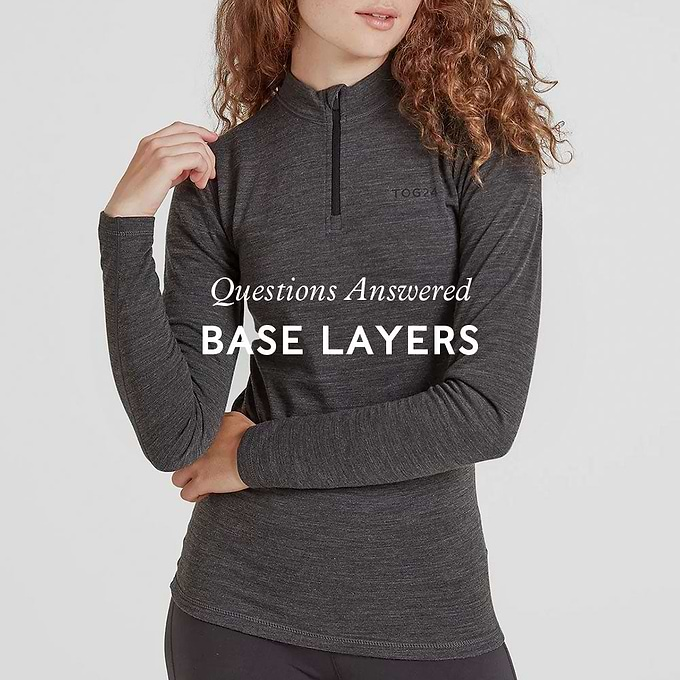
Base layers: your questions answered
When you’re out and about exploring in winter, base layers are super essential. They form one part of the three-layer system that’s designed to keep you dry and warm. The base layer acts to remove moisture from your body, whilst a mid-layer keeps you warm and an outer layer protects you from the elements.
So, if you’re considering investing in some new base layers, this is what you need to know.
What is a base layer?
A base layer is the layer that sits closest to your skin. It should act as a second skin throughout the day when you’re out exercising or adventuring. It works by providing a layer of warmth while absorbing and evaporating your sweat – this helps to keep you feeling warm and comfortable. When you’re shopping for base layers, you should look for those that are quick wicking, i.e. that they wick away your sweat rather than absorb it.
Do I need a base layer?
It depends on the exercise you’re doing. If you’re going out for a run in the depths of winter, walking for long hours in cold conditions or heading to the top of the slopes with your skis or snowboard, then base layers are essential. If you’re exercising in cold conditions and you don’t have a base layer your sweat can be absorbed by your clothes, which will cool and in turn cool your body temperature. When working up a sweat in cold conditions, a base layer is key.
Base layers should be worn alongside a mid-layer and an outer-layer, with the three working together to keep you both warm and dry in cold and wet conditions.
Is a base layer the same as a thermal?
Kind of. The best way to view thermals is as a type of base layer. Thermals focus more on keeping you warm, rather than wicking away sweat. If you know you’re going to be in the outdoors in the cold but won’t be working up a sweat, then thermals would likely be the best choice. Base layers will also keep you warm, but they’re also made from specialised materials that work to wick away sweat too. So if you’re out in cold temperatures hiking, skiing or running, base layers will keep you more comfortable in these physically intense scenarios as they’ll get rid of the sweat from your skin which can leave you feeling cold.
What is the warmest base layer for skiing?
Heading on a skiing adventure sometime soon? Base layers will be an essential part of your skiing kit. But which materials work best for time on the slopes?
Cotton is a no-go. By choosing cotton, you’ll opt for something that may keep you warm in theory, but the material won’t wick away sweat. This means it will absorb and hold onto the moisture, and once the wet cotton cools it will cool your body temperature too which can be dangerous.
For skiing you should opt for base layers made from synthetic materials or merino wool. Synthetic materials will comfortably wick away sweat, keeping you dry and warm. Merino wool on the other hand will trap the moisture while still feeling warm and comfortable on your skin.
What are base layer tights?
Base later tights are thin, comfortable leggings that are designed to wick away sweat to manage moisture effectively and create a layer of warmth. You can wear them under your trousers or under your shorts when running for example.
Remember, the key factor about base layers is how they regulate your temperature and deal with your sweat. If you simply opt for standard leggings as a base layer for your legs, they won’t do the job as effectively as proper base layers. This can result in you getting colder, meaning the wrong kit can be counterproductive.
Can you wear two base layers?
If the weather is really cold, you can choose to wear two base layers. Opting for two layers will still help you wick away the moisture when you sweat, so you’ll still feel dry and comfortable. Two base layers can also work to trap heat close to your body.
Just remember that base layers are designed to be tight-fitting, so you might find that your movement is restricted slightly if you don a couple of pairs.
How to use base layer clothing?
Base layers should be worn as part of a three-layer system that works to keep you warm and dry when you’re out in the great outdoors.
Your base layer is the first essential layer and works to wick away any moisture from your body – if you don’t have this and you sweat in cold temperatures, your body temperature can drop quickly. The second layer you need is a mid-layer like a fleece that is designed to keep you warm, with the third and final layer being a coat or jacket that protects against the elements. Sticking to the three layer system is the best way to beat the elements in winter – in fact, you’ll stay warmer with three thinner layers than simply opting for one big coat.
Sold on base layers? Any explorer or adventurer worth their salt will tell you the importance of good base layers. So whether you’re skiing, hiking or camping they should always form a key part of your outdoors kit.